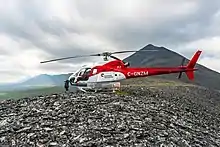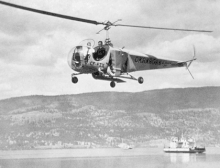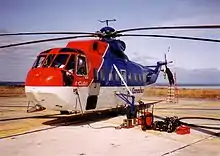Canadian Helicopters
Canadian Helicopters, formerly a part of CHC Helicopter Canadian operations, operates 112 aircraft from 26 bases across Canada which provides a broad range of helicopter services to include: emergency medical services, infrastructure maintenance, utilities, oil and gas, forestry, mining and construction, and helicopter transportation services. CH also operates an advanced flight school and provides third party repair and maintenance services. Canadian Helicopters also provides helicopter service in the United States in support of specialty operations including forest fire suppression activities and geophysical exploration programs.
 | |||||||
 Porcupine Caribou heard filming project in the Richardson Ranges - Inuvik, NT (July 2019) | |||||||
| |||||||
| Founded | Okanagan Helicopters (1947) | ||||||
|---|---|---|---|---|---|---|---|
| Commenced operations | St. John's, Newfoundland (1987) | ||||||
| AOC # | Nova Scotia: 18373[1] Quebec: 11988[2] | ||||||
| Operating bases | AB, BC, MB, NB, NL, NT, NS, NU, QC, YK | ||||||
| Fleet size | 112 (110 & 2)[3] | ||||||
| Headquarters | Les Cèdres, Quebec, Canada | ||||||
| Website | www | ||||||
History


Commercial helicopter flying began in British Columbia in the summer of 1947. Three former Royal Canadian Air Force officers, pilots Carl Agar and Barney Bent, and engineer Alf Stringer, were operating a fixed-wing charter company, Okanagan Air Services Ltd., out of Penticton. In July 1947 they raised enough money to purchase a Bell 47-B3 and pay for their flying and maintenance training.
Okanagan Air Services moved to Vancouver in 1949, was renamed Okanagan Helicopters Ltd. and, by 1954, had become the largest commercial helicopter operator in the world.
Toronto Helicopters was founded by Len Routledge and Douglas Dunlop. It was a pioneer in air ambulance services in Ontario and operated helicopters for the Ontario Ministry of Health. [4] [5] [6]
Sealand Helicopters was founded by Newfoundland businessman Craig Dobbin in February 1977.
In 1987, Dobbin headed a group that purchased Okanagan Helicopters and Toronto Helicopters and merged them with his own company, Sealand Helicopters to form Canadian Helicopters.[7]
Until November 2000, Canadian Helicopters was the domestic operating arm of Canadian Helicopters International, a wholly owned subsidiary of CHC Helicopter Corporation. In 2000, Canadian Helicopters was divested to form Canadian Helicopters, Inc which was then renamed in 2012 as HNZ Group, Inc.. In December 2017, the company was taken private.[8]
As of September 2019, Canadian Helicopters has two air operator's certificates. The first, 18373, is Canadian Helicopters Limited - Hélicoptères Canadiens Limitée trading as Canadian Helicopters Offshore in Enfield, Nova Scotia with two helicopters in Goffs (Halifax Stanfield International Airport).[1][9][10] The second, 11988, is used for the rest of the fleet in Les Cèdres, Quebec.[2][3]
Bases
The following are bases in Canada:[11]
- Alberta - Western Head Office Edmonton International Airport, Fort McMurray International Airport, Grande Prairie Airport
- British Columbia - Fort Nelson Airport, Fort St. John Airport, Penticton Regional Airport (flight school), Smithers Airport, Northwest Regional Airport Terrace-Kitimat
- Manitoba - Portage la Prairie/Southport Airport (DND Training & Maintenance Support, Allied Wings)
- New Brunswick - Fredericton International Airport
- Newfoundland and Labrador - Bishop's Falls, Goose Bay Airport, Pasadena
- Northwest Territories - Inuvik (Mike Zubko) Airport, Norman Wells Airport, Yellowknife Airport
- Nova Scotia - Halifax Stanfield International Airport (Halifax EMS and offshore)
- Nunavut - Cambridge Bay Airport, Hall Beach Airport, Iqaluit Airport
- Quebec - Corporate Head Office: Montreal, (Les Cèdres), Chevery Airport, La Grande Rivière Airport (Radisson, Whapchiwem), Sept-Îles Airport
- Yukon - Erik Nielsen Whitehorse International Airport
Heliports
Canadian Helicopters operates the following heliports:[12]
- Chibougamau Heliport, Chibougamau, Quebec
- Montréal/Les Cèdres Heliport, Montreal, Quebec
- Sagard Heliport, Sagard, Quebec
- Smithers (Canadian) Heliport, Smithers, British Columbia
Fleet
As of September 2019, Canadian Helicopters has the following aircraft registered with Transport Canada:[3]

_02.JPG.webp)
| Aircraft | No. of aircraft | Variants | Notes |
|---|---|---|---|
| Eurocopter AS350 Écureuil (Aerospatiale AS350) | 38 | AS350 B2, AS350 B3 | Single engine |
| Aerospatiale AS 355 | 8 | AS 355-N | Twin engine, listed at Canadian Helicopters as an Airbus |
| Bell 206 | 10 | 206B, LongRanger | Single engine |
| Bell 212 | 8 | 212 | Twin engine |
| Bell 407 | 5 | 407 | Single engine |
| Bell 412 | 1 | 412EP | Twin engine |
| Eurocopter EC120 | 4 | EC120B Colibri | Single engine, listed at Canadian Helicopters as an Airbus |
| Sikorsky S-61 | 3 | S-61N | Twin engine |
| Sikorsky S-76 | 4 | S-76A++, S-76C+, S-76D | Twin engine |
The aircraft are listed by Transport Canada as being registered to Canadian Helicopters Limited - Hélicoptères Canadiens Limitée registered in Quebec.[3][9][10]
The Transport Canada list also shows an Aerospatiale AS350D,[13] an Aerospatiale AS 355F1,[14] a Bell 212,[15] a Bell 206B,[16] a Robinson R22 BETA,[17] and two Sikorsky S-76A[18][19] all with cancelled certificates.
References
- Transport Canada (2019-09-09), Civil Aviation Services (CAS) AOC. wwwapps.tc.gc.ca.
- Transport Canada (2019-09-09), Civil Aviation Services (CAS) AOC. wwwapps.tc.gc.ca.
- "Canadian Civil Aircraft Register: Quick Search Result for Canadian Helicopters". Transport Canada. Retrieved 2019-09-09.
- "ATAC mourns the passing Len Routledge". Air Transport Society of Canada. Retrieved 2017-09-03.
- "Leonard Victor Routledge obiturary". The Toronto Star. June 1, 2013. Retrieved 2017-09-04.
- "Douglas Weir Dunlop Obituary". The Toronto Star. 29 April 2014.
- "Canadian helicopter operators shake up" (PDF). flightglobal.com. 23 May 1987.
- Inc, HNZ Group. "HNZ Group Inc. to be acquired by President and CEO Don Wall and PHI, Inc". www.newswire.ca. Retrieved 2021-01-12.
- Canadian Civil Aircraft Register: Aircraft Details C-GNZH
- Canadian Civil Aircraft Register: Aircraft Details C-GICB
- Locations
- Canada Flight Supplement. Effective 0901Z 16 July 2020 to 0901Z 10 September 2020.
- Civil Aircraft Register: Aircraft Details C-GCKP
- Civil Aircraft Register: Aircraft Details C-GVHK
- Civil Aircraft Register: Aircraft Details C-GOKY
- Civil Aircraft Register: Aircraft Details C-GBHE
- Civil Aircraft Register: Aircraft Details C-GEBO
- Civil Aircraft Register: Aircraft Details C-GFFJ
- Civil Aircraft Register: Aircraft Details C-GIMR